Water extract of Humulus japonicus improves age‑related cognitive decline by inhibiting acetylcholinesterase activity and the acetylcholine signaling pathway
- Authors:
- Ju-Eun Kim
- Kyeong-Seon Min
- Jun Go
- Hye-Yeon Park
- Young-Keun Choi
- In-Bok Lee
- Jaewon Shin
- Hyun-Ju Cho
- Hong-Sik Kim
- Dae Youn Hwang
- Won-Keun Oh
- Kyoung-Shim Kim
- Chul-Ho Lee
-
Affiliations: Laboratory Animal Resource Center, Korea Research Institute of Bioscience and Biotechnology, Daejeon 34141, Republic of Korea, Korea Bioactive Natural Material Bank, Research Institute of Pharmaceutical Sciences, College of Pharmacy, Seoul National University, Seoul 08826, Republic of Korea, NHB Co., Ltd., Seoul 04735, Republic of Korea, PENS Co., Ltd., Seoul 07206, Republic of Korea, Department of Biomaterials Science, College of Natural Resources and Life Science/Life and Industry Convergence Research Institute, Pusan National University, Miryang, South Gyeongsang 50463, Republic of Korea - Published online on: March 18, 2025 https://doi.org/10.3892/mmr.2025.13496
- Article Number: 131
-
Copyright: © Kim et al. This is an open access article distributed under the terms of Creative Commons Attribution License.
This article is mentioned in:
Abstract
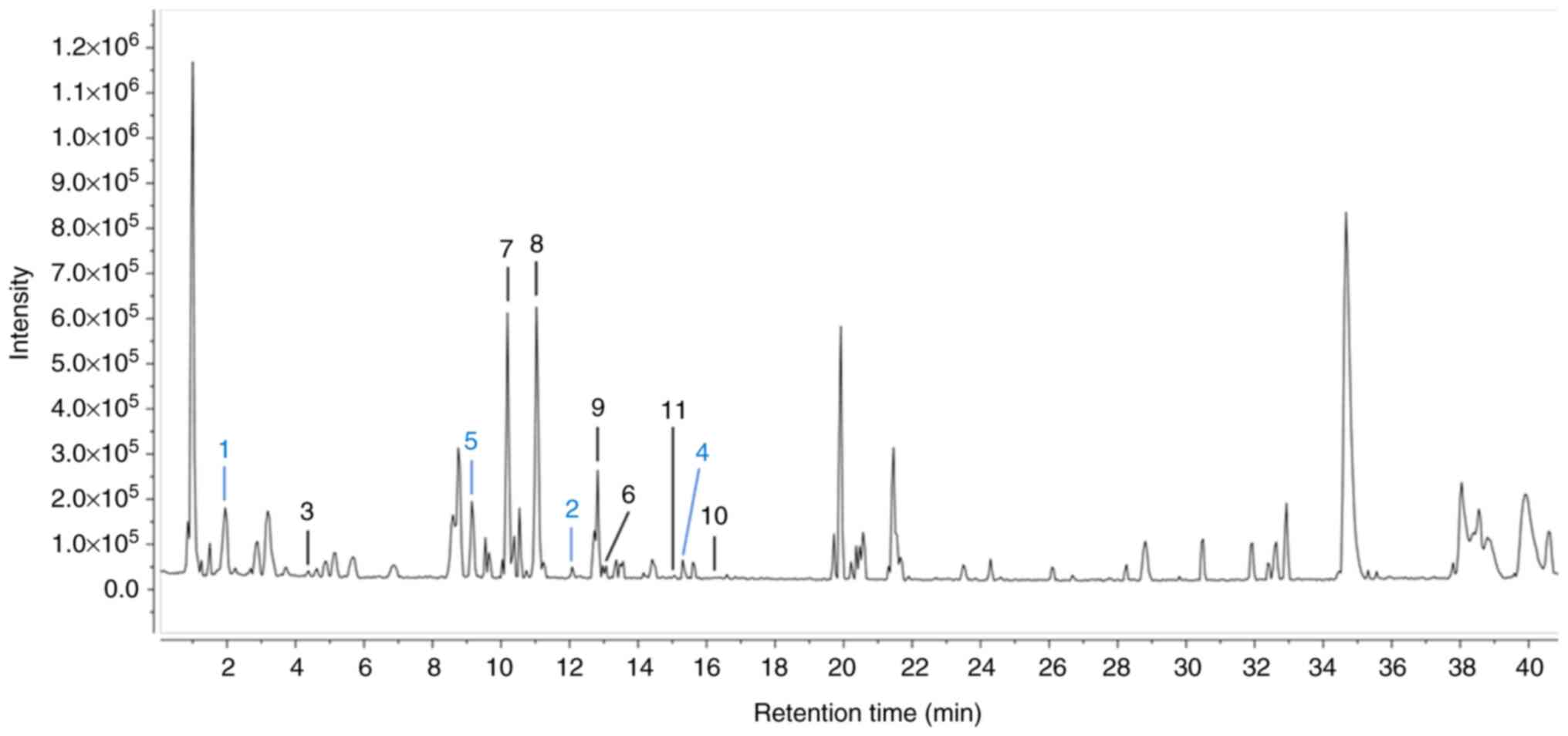 |
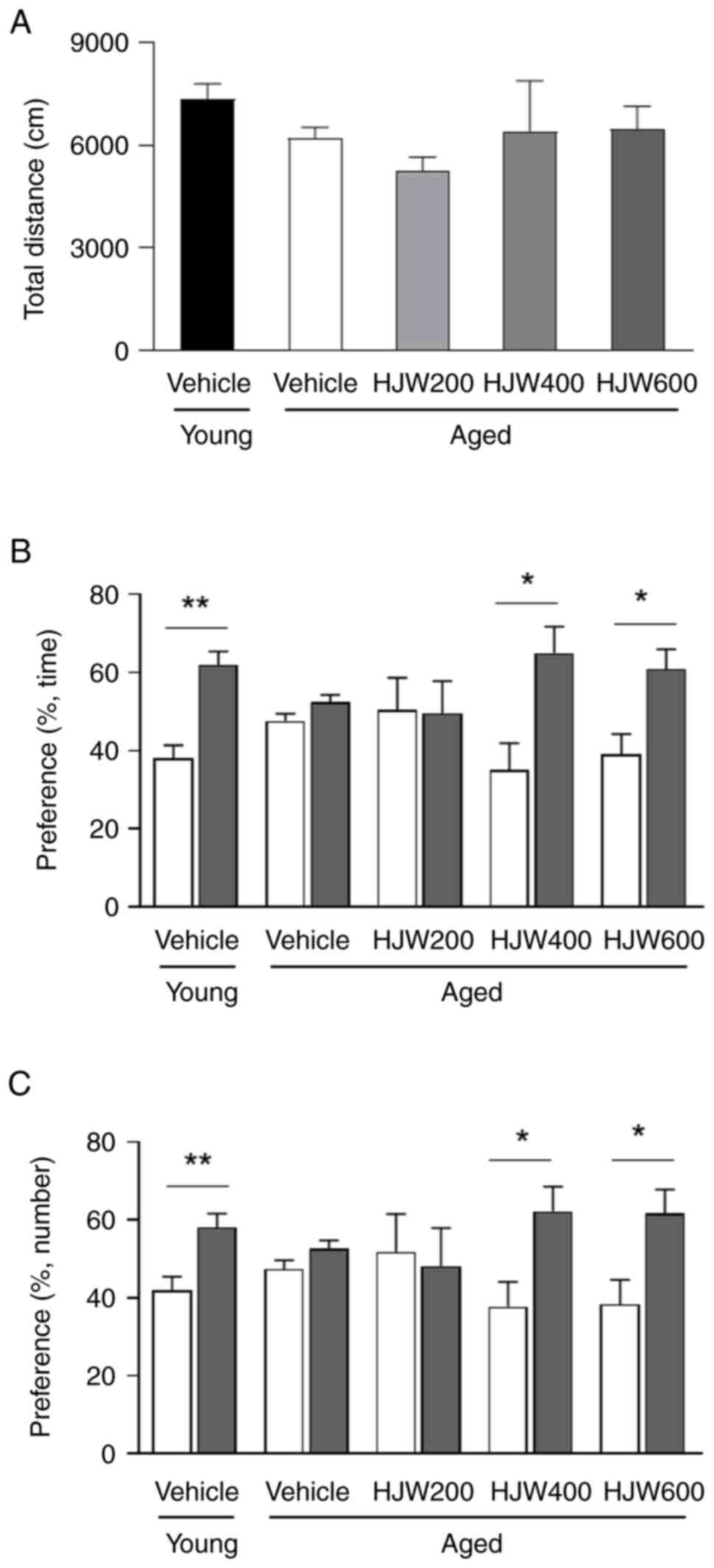 |
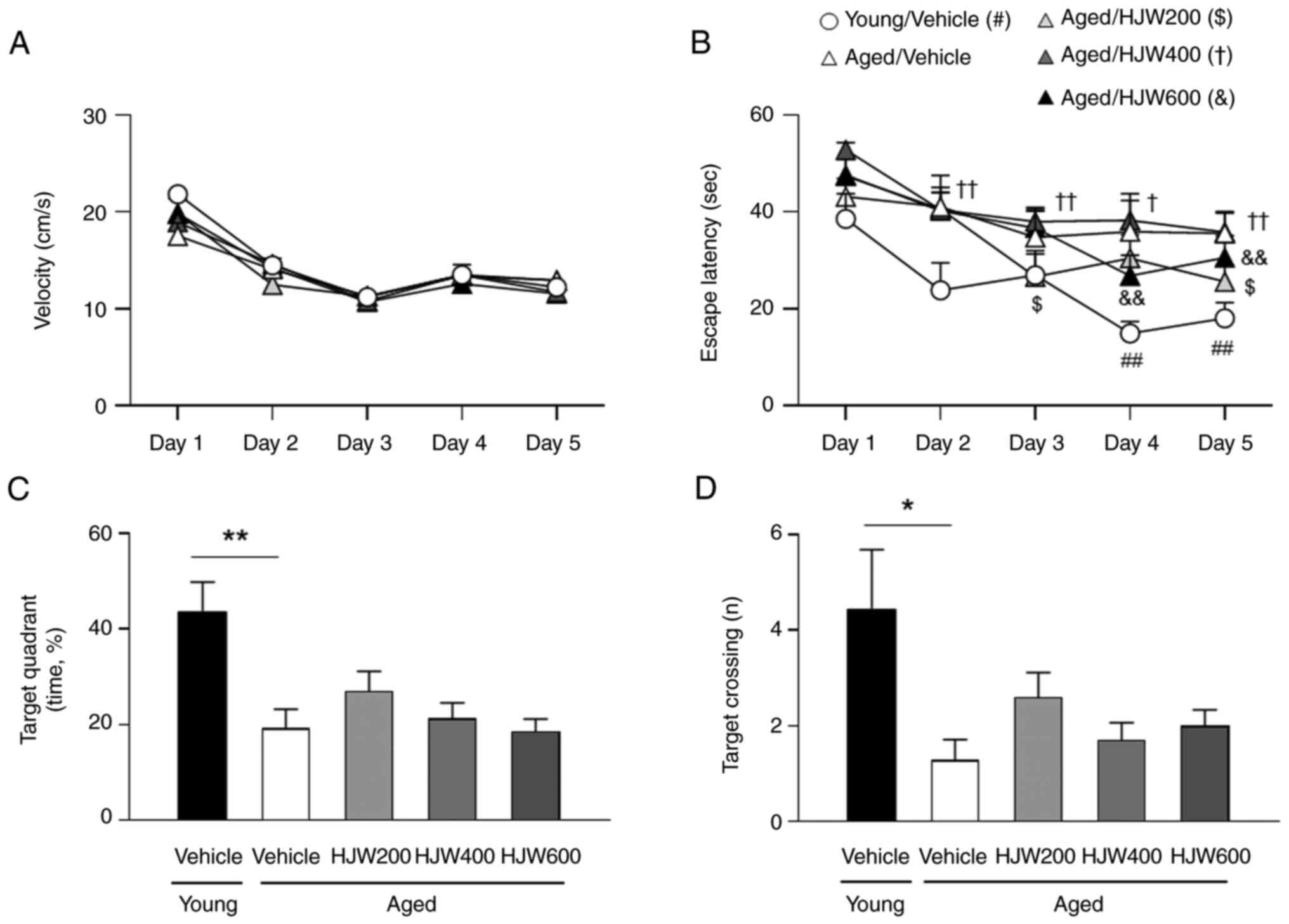 |
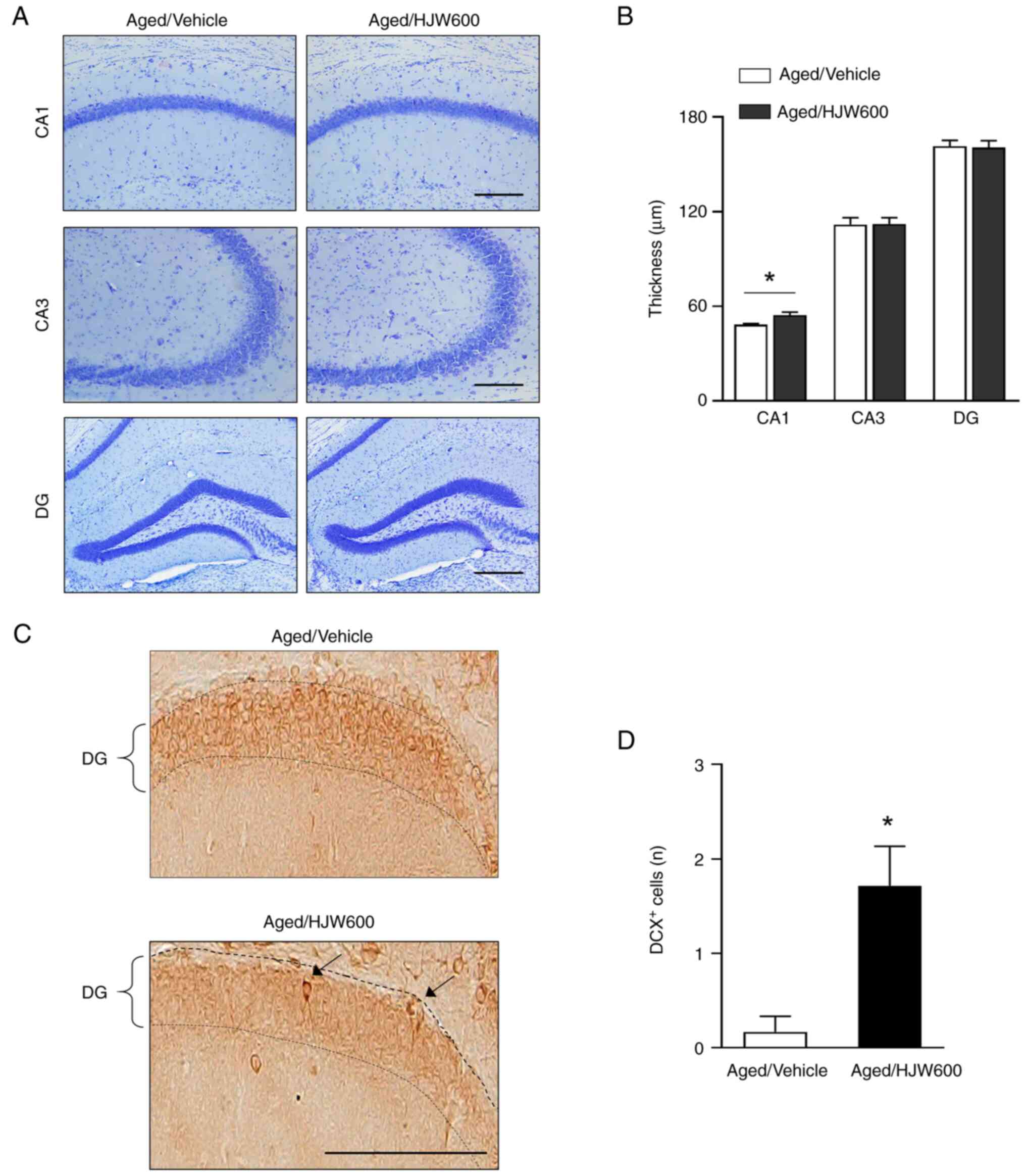 |
 |
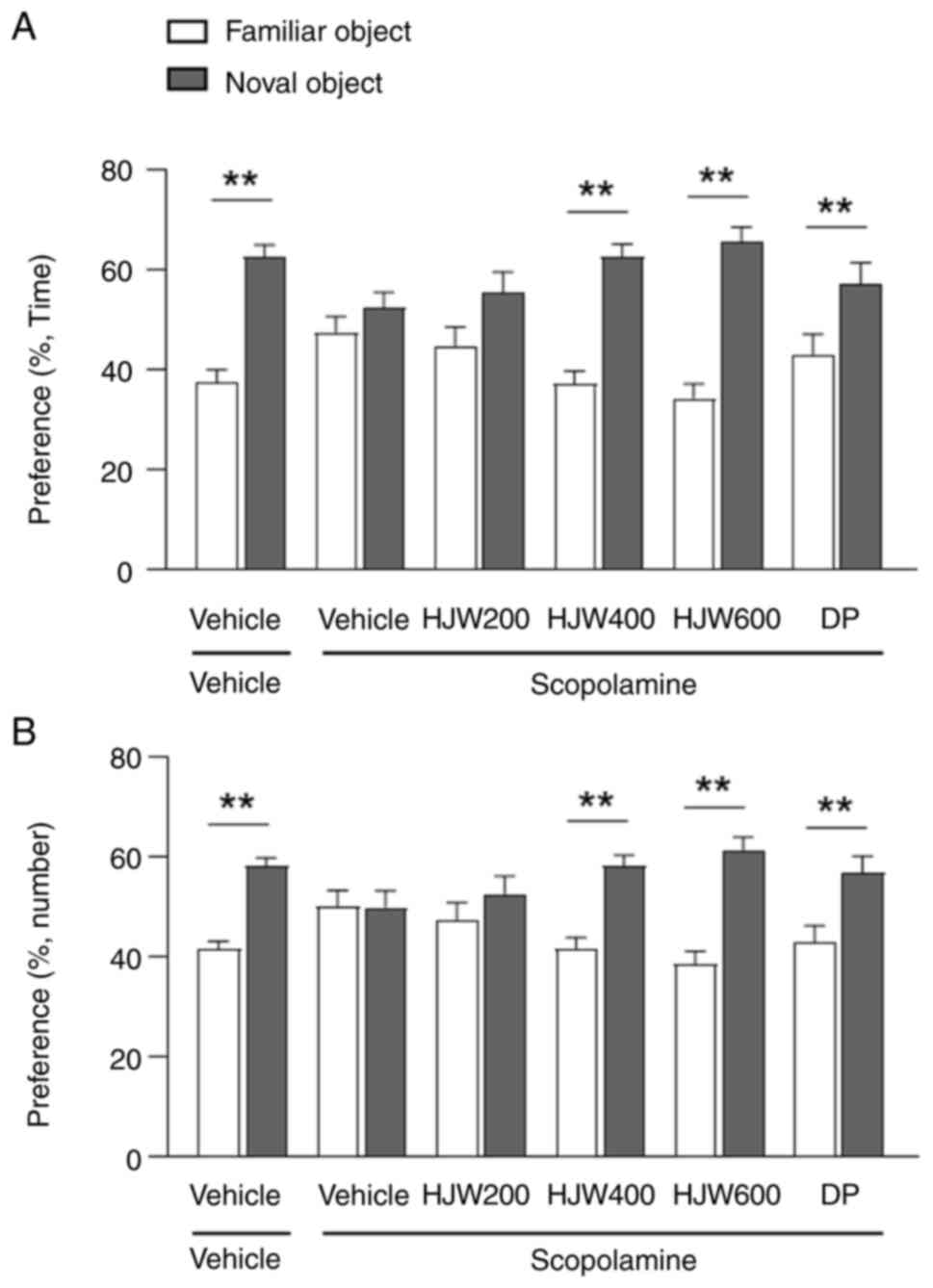 |
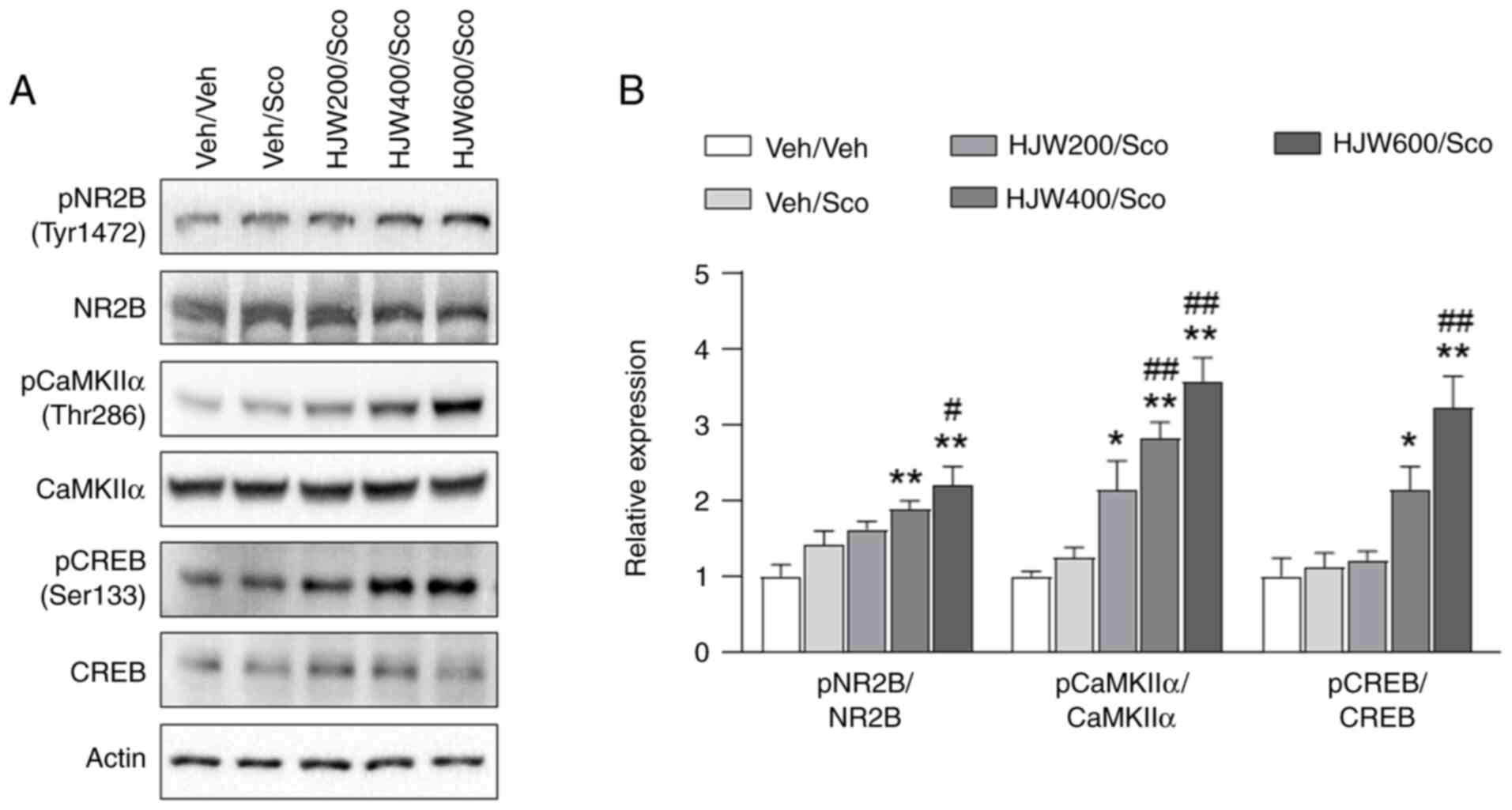 |
 |
|
Nicholls LAB, Amanzio M, Guntekin B and Keage H: Editorial: The cognitive ageing collection. Sci Rep. 14:108692024. View Article : Google Scholar : PubMed/NCBI | |
|
Hebert LE, Scherr PA, Bienias JL, Bennett DA and Evans DA: Alzheimer disease in the US population: prevalence estimates using the 2000 census. Arch Neurol. 60:1119–1122. 2003. View Article : Google Scholar : PubMed/NCBI | |
|
Flores G, Flores-Gomez GD, Diaz A, Penagos-Corzo JC, Iannitti T and Morales-Medina JC: Natural products present neurotrophic properties in neurons of the limbic system in aging rodents. Synapse. 75:e221852020. View Article : Google Scholar : PubMed/NCBI | |
|
Zaninotto P, Batty GD, Allerhand M and Deary IJ: Cognitive function trajectories and their determinants in older people: 8 years of follow-up in the english longitudinal study of ageing. J Epidemiol Community Health. 72:685–694. 2018. View Article : Google Scholar : PubMed/NCBI | |
|
Blinkouskaya Y and Weickenmeier J: Brain shape changes associated with cerebral atrophy in healthy aging and Alzheimer's disease. Front Mech Eng. 7:7056532021. View Article : Google Scholar : PubMed/NCBI | |
|
Chen L, Jiao J and Zhang Y: Therapeutic approaches for improving cognitive function in the aging brain. Front Neurosci. 16:10605562022. View Article : Google Scholar : PubMed/NCBI | |
|
Dickstein DL, Kabaso D, Rocher AB, Luebke JI, Wearne SL and Hof PR: Changes in the structural complexity of the aged brain. Aging Cell. 6:275–284. 2007. View Article : Google Scholar : PubMed/NCBI | |
|
Picciotto MR, Higley MJ and Mineur YS: Acetylcholine as a neuromodulator: Cholinergic signaling shapes nervous system function and behavior. Neuron. 76:116–129. 2012. View Article : Google Scholar : PubMed/NCBI | |
|
Rasmusson DD: The role of acetylcholine in cortical synaptic plasticity. Behav Brain Res. 115:205–218. 2000. View Article : Google Scholar : PubMed/NCBI | |
|
Madrid LI, Jimenez-Martin J, Coulson EJ and Jhaveri DJ: Cholinergic regulation of adult hippocampal neurogenesis and hippocampus-dependent functions. Int J Biochem Cell Biol. 134:1059692021. View Article : Google Scholar : PubMed/NCBI | |
|
Mustafab I, Elkamel A, Ibrahim G, Elnashaie S and Chen P: Effect of Choline and acetate substrates on bifurcation and chaotic behavior of acetylcholine neurocycle and Alzheimer's and Parkinson's diseases. Journal of chemical engineering science. 64:2096–2112. 2009. View Article : Google Scholar | |
|
Moreira EL, de Oliveira J, Nunes JC, Santos DB, Nunes FC, Vieira DS, Ribeiro-do-Valle RM, Pamplona FA, de Bem AF, Farina M, et al: Age-related cognitive decline in hypercholesterolemic LDL receptor knockout mice (LDLr-/-): evidence of antioxidant imbalance and increased acetylcholinesterase activity in the prefrontal cortex. J Alzheimers Dis. 32:495–511. 2012. View Article : Google Scholar : PubMed/NCBI | |
|
Hafez HS, Ghareeb DA, Saleh SR, Abady MM, El Demellawy MA, Hussien H and Abdel-Monem N: Neuroprotective effect of ipriflavone against scopolamine-induced memory impairment in rats. Psychopharmacology (Berl). 234:3037–3053. 2017. View Article : Google Scholar : PubMed/NCBI | |
|
Blake MG, Krawczyk MC, Baratti CM and Boccia MM: Neuropharmacology of memory consolidation and reconsolidation: Insights on central cholinergic mechanisms. J Physiol Paris. 108:286–291. 2014. View Article : Google Scholar : PubMed/NCBI | |
|
Gasiorowska A, Wydrych M, Drapich P, Zadrozny M, Steczkowska M, Niewiadomski W and Niewiadomska G: The biology and pathobiology of glutamatergic, cholinergic and dopaminergic signaling in the aging brain. Front Aging Neurosci. 13:6549312021. View Article : Google Scholar : PubMed/NCBI | |
|
Chen ZR, Huang JB, Yang SL and Hong FF: Role of cholinergic signaling in Alzheimer's disease. Molecules. 27:18162022. View Article : Google Scholar : PubMed/NCBI | |
|
Muller ML and Bohnen NI: Cholinergic dysfunction in Parkinson's disease. Curr Neurol Neurosci Rep. 13:3772013. View Article : Google Scholar : PubMed/NCBI | |
|
Go J, Park HY, Lee DW, Maeng SY, Lee IB, Seo YJ, An JP, Oh WK, Lee CH and Kim KS: Humulus japonicus attenuates LPS-and scopolamine-induced cognitive impairment in mice. Lab Anim Res. 38:212022. View Article : Google Scholar : PubMed/NCBI | |
|
Kim YB, Kang EJ, Noh JR, An JP, Park JT, Oh WK, Kim YH and Lee CH: Humulus japonicus ameliorates irritant contact dermatitis by suppressing NF-ĸB p65-dependent inflammatory responses in mice. Exp Ther Med. 26:4462023. View Article : Google Scholar : PubMed/NCBI | |
|
Sung B, Chung JW, Bae HR, Choi JS, Kim CM and Kim ND: Humulus japonicus extract exhibits antioxidative and anti-aging effects via modulation of the AMPK-SIRT1 pathway. Exp Ther Med. 9:1819–1826. 2015. View Article : Google Scholar : PubMed/NCBI | |
|
McPartland JM: Cannabis systematics at the levels of family, genus and species. Cannabis Cannabinoid Res. 3:203–212. 2018. View Article : Google Scholar : PubMed/NCBI | |
|
Ovidi E, Laghezza Masci V, Taddei AR, Torresi J, Tomassi W, Iannone M, Tiezzi A, Maggi F and Garzoli S: Hemp (Cannabis sativa L., Kompolti cv.) and Hop (Humulus lupulus L., Chinook cv.) essential oil and hydrolate: HS-GC-MS chemical investigation and apoptotic activity evaluation. Pharmaceuticals (Basel). 15:9762022. View Article : Google Scholar : PubMed/NCBI | |
|
Carbone K and Gervasi F: An updated review of the genus humulus: A valuable source of bioactive compounds for health and disease prevention. Plants (Basel). 11:34342022.PubMed/NCBI | |
|
Lee HJ, Dhodary B, Lee JY, An JP, Ryu YK, Kim KS, Lee CH and Oh WK: Dereplication of components coupled with HPLC-qTOF-MS in the active fraction of humulus japonicus and it's protective effects against Parkinson's disease mouse model. Molecules. 24:14352019. View Article : Google Scholar : PubMed/NCBI | |
|
Ryu YK, Kang Y, Go J, Park HY, Noh JR, Kim YH, Hwang JH, Choi DH, Han SS, Oh WK, et al: Humulus japonicus prevents dopaminergic neuron death in 6-hydroxydopamine-induced models of Parkinson's disease. J Med Food. 20:116–123. 2017. View Article : Google Scholar : PubMed/NCBI | |
|
Park TS, Ryu YK, Park HY, Kim JY, Go J, Noh JR, Kim YH, Hwang JH, Choi DH, Oh WK, et al: Humulus japonicus inhibits the progression of Alzheimer's disease in a APP/PS1 transgenic mouse model. Int J Mol Med. 39:21–30. 2017. View Article : Google Scholar : PubMed/NCBI | |
|
Thein W, Choi WS, Po WW, Khing TM, Jeong JH and Sohn UD: Ameliorative effects of Humulus japonicus extract and polysaccharide-rich extract of Phragmites rhizoma in rats with gastrointestinal dysfunctions induced by water avoidance stress. Evid Based Complement Alternat Med. 2022:99937432022. View Article : Google Scholar : PubMed/NCBI | |
|
Kim OK, Yun JM, Lee M, Park SJ, Kim D, Oh DH, Kim HS and Kim GY: A mixture of humulus japonicus increases longitudinal bone growth rate in sprague dawley rats. Nutrients. 12:26252020. View Article : Google Scholar : PubMed/NCBI | |
|
Chung YH, Bang JS, Kang CM, Goh JW, Lee HS, Hong SM, Kim DS, Park ES, Jung TW, Shin YK, et al: Aqueous extract of humulus japonicus attenuates hyperlipidemia and fatty liver in obese mice. J Med Food. 21:999–1008. 2018. View Article : Google Scholar : PubMed/NCBI | |
|
Falsafi SK, Deli A, Hoger H, Pollak A and Lubec G: Scopolamine administration modulates muscarinic, nicotinic and NMDA receptor systems. PLoS One. 7:e320822012. View Article : Google Scholar : PubMed/NCBI | |
|
Kim CY, Seo Y, Lee C, Park GH and Jang JH: Neuroprotective effect and molecular mechanism of [6]-gingerol against scopolamine-induced amnesia in C57BL/6 mice. Evid Based Complement Alternat Med. 2018:89415642018. View Article : Google Scholar : PubMed/NCBI | |
|
Garber JC, Barbee RW, Beelitzki JT, et al: Guide for the care and use of laboratory animals. 8th Edition. National Academies Press; Washington, DC: pp. 1–246. 2011 | |
|
Seibenhener ML and Wooten MC: Use of the open field maze to measure locomotor and anxiety-like behavior in mice. J Vis Exp. 6:e524342015.PubMed/NCBI | |
|
Shang Q, Chen G, Zhang P, Zhao W, Chen H, Yu D, Yu F, Liu H, Zhang X, He J, et al: Myristic acid alleviates hippocampal aging correlated with GABAergic signaling. Front Nutr. 9:9075262022. View Article : Google Scholar : PubMed/NCBI | |
|
Lueptow LM: Novel object recognition test for the investigation of learning and memory in mice. J Vis Exp. 557182017.PubMed/NCBI | |
|
Vorhees CV and Williams MT: Morris water maze: Procedures for assessing spatial and related forms of learning and memory. Nat Protoc. 1:848–858. 2006. View Article : Google Scholar : PubMed/NCBI | |
|
Go J, Maeng SY, Chang DH, Park HY, Min KS, Kim JE, Choi YK, Noh JR, Ro H, Kim BC, et al: Agathobaculum butyriciproducens improves ageing-associated cognitive impairment in mice. Life Sci. 339:1224132024. View Article : Google Scholar : PubMed/NCBI | |
|
Wang DM, Yang YJ, Zhang L, Zhang X, Guan FF and Zhang LF: Naringin enhances CaMKII activity and improves long-term memory in a mouse model of Alzheimer's disease. Int J Mol Sci. 14:5576–5586. 2013. View Article : Google Scholar : PubMed/NCBI | |
|
Gomez-Oliva R, Martinez-Ortega S, Atienza-Navarro I, Domínguez-García S, Bernal-Utrera C, Geribaldi-Doldán N, Verástegui C, Ezzanad A, Hernández-Galán R, Nunez-Abades P, et al: Rescue of neurogenesis and age-associated cognitive decline in SAMP8 mouse: Role of transforming growth factor-alpha. Aging Cell. 22:e138292023. View Article : Google Scholar : PubMed/NCBI | |
|
Ge W, Ren C, Xing L, Guan L, Zhang C, Sun X, Wang G, Niu H and Qun S: Ginkgo biloba extract improves cognitive function and increases neurogenesis by reducing Abeta pathology in 5×FAD mice. Am J Transl Res. 13:1471–1482. 2021.PubMed/NCBI | |
|
Garcia-Cabezas MA, John YJ, Barbas H and Zikopoulos B: Distinction of neurons, glia and endothelial cells in the cerebral cortex: An algorithm based on cytological features. Front Neuroanat. 10:1072016. View Article : Google Scholar : PubMed/NCBI | |
|
Jang S, Chun JH and Kim KB: Analysis on recent studies trends of humulus japonicus-focusing on research of medical sciences. J Pediatrics Korean Med. 38:97–112. 2024. | |
|
Sun JL, Kim YJ, Cho W, Park SS, Abd El-Aty AM, Mobarak EH, Jung TW and Jeong JH: The extract of humulus japonicus inhibits lipogenesis and promotes lipolysis via PKA/p38 signaling. Obes Facts. 17:513–523. 2024. View Article : Google Scholar : PubMed/NCBI | |
|
Antunes M and Biala G: The novel object recognition memory: neurobiology, test procedure and its modifications. Cogn Process. 13:93–110. 2012. View Article : Google Scholar : PubMed/NCBI | |
|
Anacker C and Hen R: Adult hippocampal neurogenesis and cognitive flexibility-linking memory and mood. Nat Rev Neurosci. 18:335–346. 2017. View Article : Google Scholar : PubMed/NCBI | |
|
Kida S: A functional role for CREB as a positive regulator of memory formation and LTP. Exp Neurobiol. 21:136–140. 2012. View Article : Google Scholar : PubMed/NCBI | |
|
Wang H, Xu J, Lazarovici P, Quirion R and Zheng W: cAMP response element-binding protein (CREB): A possible signaling molecule link in the pathophysiology of schizophrenia. Front Mol Neurosci. 11:2552018. View Article : Google Scholar : PubMed/NCBI | |
|
Kang CM, Bang JS, Park SY, Jung TW, Kim HC, Chung YH and Jeong JH: The aqueous extract of humulus japonicus ameliorates cognitive dysfunction in Alzheimer's disease models via modulating the cholinergic system. J Med Food. 25:943–951. 2022.PubMed/NCBI | |
|
Anand KS and Dhikav V: Hippocampus in health and disease: An overview. Ann Indian Acad Neurol. 15:239–246. 2012. View Article : Google Scholar : PubMed/NCBI | |
|
Zhao C, Deng W and Gage FH: Mechanisms and functional implications of adult neurogenesis. Cell. 132:645–660. 2008. View Article : Google Scholar : PubMed/NCBI | |
|
Kang EJ, Kim JH, Kim YE, Lee H, Jung KB, Chang DH, Lee Y, Park S, Lee EY, Lee EJ, et al: The secreted protein Amuc_1409 from Akkermansia muciniphila improves gut health through intestinal stem cell regulation. Nat Commun. 15:29832024. View Article : Google Scholar : PubMed/NCBI | |
|
Zeng Q, Zheng M, Zhang T and He G: Hippocampal neurogenesis in the APP/PS1/nestin-GFP triple transgenic mouse model of Alzheimer's disease. Neuroscience. 314:64–74. 2016. View Article : Google Scholar : PubMed/NCBI | |
|
Ding Y, Li L, Wang S, Cao Y, Yang M, Dai Y, Lin H, Li J, Liu Y, Wang Z, et al: Electroacupuncture promotes neurogenesis in the dentate gyrus and improves pattern separation in an early Alzheimer's disease mouse model. Biol Res. 56:652023. View Article : Google Scholar : PubMed/NCBI | |
|
Culig L, Chu X and Bohr VA: Neurogenesis in aging and age-related neurodegenerative diseases. Ageing Res Rev. 78:1016362022. View Article : Google Scholar : PubMed/NCBI | |
|
McGinley LM, Kashlan ON, Bruno ES, Chen KS, Hayes JM, Kashlan SR, Raykin J, Johe K, Murphy GG and Feldman EL: Human neural stem cell transplantation improves cognition in a murine model of Alzheimer's disease. Sci Rep. 8:147762018. View Article : Google Scholar : PubMed/NCBI | |
|
Gleeson JG, Lin PT, Flanagan LA and Walsh CA: Doublecortin is a microtubule-associated protein and is expressed widely by migrating neurons. Neuron. 23:257–271. 1999. View Article : Google Scholar : PubMed/NCBI | |
|
Hampel H, Vergallo A, Afshar M, Akman-Anderson L, Arenas J, Benda N, Batrla R, Broich K, Caraci F, Cuello AC, et al: Blood-based systems biology biomarkers for next-generation clinical trials in Alzheimer's disease. Dialogues Clin Neurosci. 21:177–191. 2019. View Article : Google Scholar : PubMed/NCBI | |
|
Schliebs R and Arendt T: The cholinergic system in aging and neuronal degeneration. Behav Brain Res. 221:555–563. 2011. View Article : Google Scholar : PubMed/NCBI | |
|
Anand P and Singh B: A review on cholinesterase inhibitors for Alzheimer's disease. Arch Pharm Res. 36:375–399. 2013. View Article : Google Scholar : PubMed/NCBI | |
|
Veena J, Rao BS and Srikumar BN: Regulation of adult neurogenesis in the hippocampus by stress, acetylcholine and dopamine. J Nat Sci Biol Med. 2:26–37. 2011. View Article : Google Scholar : PubMed/NCBI | |
|
Cooper-Kuhn CM, Winkler J and Kuhn HG: Decreased neurogenesis after cholinergic forebrain lesion in the adult rat. J Neurosci Res. 77:155–165. 2004. View Article : Google Scholar : PubMed/NCBI | |
|
Marucci G, Buccioni M, Ben DD, Lambertucci C, Volpini R and Amenta F: Efficacy of acetylcholinesterase inhibitors in Alzheimer's disease. Neuropharmacology. 190:1083522021. View Article : Google Scholar : PubMed/NCBI | |
|
Zucker RS: Calcium- and activity-dependent synaptic plasticity. Curr Opin Neurobiol. 9:305–313. 1999. View Article : Google Scholar : PubMed/NCBI | |
|
Rotenberg A, Mayford M, Hawkins RD, Kandel ER and Muller RU: Mice expressing activated CaMKII lack low frequency LTP and do not form stable place cells in the CA1 region of the hippocampus. Cell. 87:1351–1361. 1996. View Article : Google Scholar : PubMed/NCBI | |
|
Omkumar RV, Kiely MJ, Rosenstein AJ, Min KT and Kennedy MB: Identification of a phosphorylation site for calcium/calmodulindependent protein kinase II in the NR2B subunit of the N-methyl-D-aspartate receptor. J Biol Chem. 271:31670–31678. 1996. View Article : Google Scholar : PubMed/NCBI | |
|
Chang JY, Parra-Bueno P, Laviv T, Szatmari EM, Lee SR and Yasuda R: CaMKII autophosphorylation is necessary for optimal integration of Ca(2+) signals during LTP induction, but not maintenance. Neuron. 94:800–808. e42017. View Article : Google Scholar : PubMed/NCBI | |
|
Giese KP, Fedorov NB, Filipkowski RK and Silva AJ: Autophosphorylation at Thr286 of the alpha calcium-calmodulin kinase II in LTP and learning. Science. 279:870–873. 1998. View Article : Google Scholar : PubMed/NCBI | |
|
Sheng M, Thompson MA and Greenberg ME: CREB: A Ca(2+)-regulated transcription factor phosphorylated by calmodulin-dependent kinases. Science. 252:1427–1430. 1991. View Article : Google Scholar : PubMed/NCBI | |
|
Saura CA and Valero J: The role of CREB signaling in Alzheimer's disease and other cognitive disorders. Rev Neurosci. 22:153–169. 2011. View Article : Google Scholar : PubMed/NCBI | |
|
Soares MO, Alves RC, Pires PC, Oliveira MB and Vinha AF: Angolan Cymbopogon citratus used for therapeutic benefits: nutritional composition and influence of solvents in phytochemicals content and antioxidant activity of leaf extracts. Food Chem Toxicol. 60:413–418. 2013. View Article : Google Scholar : PubMed/NCBI | |
|
Cieniak C, Walshe-Roussel B, Liu R, Muhammad A, Saleem A, Haddad PS, Cuerrier A, Foster BC and Arnason JT: Phytochemical comparison of the water and ethanol leaf extracts of the cree medicinal plant, Sarracenia purpurea L. (Sarraceniaceae). J Pharm Pharm Sci. 18:484–493. 2015. View Article : Google Scholar : PubMed/NCBI | |
|
Wang H, Wang H, Cheng H and Che Z: Ameliorating effect of luteolin on memory impairment in an Alzheimer's disease model. Mol Med Rep. 13:4215–4220. 2016. View Article : Google Scholar : PubMed/NCBI | |
|
Liu R, Gao M, Qiang GF, Zhang TT, Lan X, Ying J and Du GH: The anti-amnesic effects of luteolin against amyloid beta(25–35) peptide-induced toxicity in mice involve the protection of neurovascular unit. Neuroscience. 162:1232–1243. 2009. View Article : Google Scholar : PubMed/NCBI | |
|
Olasehinde TA and Olaokun OO: The beneficial role of apigenin against cognitive and neurobehavioural dysfunction: A systematic review of preclinical investigations. Biomedicines. 12:1782024. View Article : Google Scholar : PubMed/NCBI | |
|
Achour M, Ferdousi F, Sasaki K and Isoda H: Luteolin modulates neural stem cells fate determination: In vitro study on human neural stem cells and in vivo study on LPS-Induced depression mice model. Front Cell Dev Biol. 9:7532792021. View Article : Google Scholar : PubMed/NCBI | |
|
Li HZ, Liu KG, Zeng NX, Wu XF, Lu WJ, Xu HF, Yan C and Wu LL: Luteolin enhances choroid plexus 5-MTHF brain transport to promote hippocampal neurogenesis in LOD rats. Front Pharmacol. 13:8265682022. View Article : Google Scholar : PubMed/NCBI | |
|
Jordan SA, Cunningham DG and Marles RJ: Assessment of herbal medicinal products: Challenges and opportunities to increase the knowledge base for safety assessment. Toxicol Appl Pharmacol. 243:198–216. 2010. View Article : Google Scholar : PubMed/NCBI | |
|
Petrovska BB: Historical review of medicinal plants' usage. Pharmacogn Rev. 6:1–5. 2012. View Article : Google Scholar : PubMed/NCBI | |
|
Agidew MG: Phytochemical analysis of some selected traditional medicinal plants in Ethiopia. Bulletin of the National Research Centre. 46:872022. View Article : Google Scholar : PubMed/NCBI | |
|
Hossain MA and Nagooru MR: Biochemical profiling and total flavonoids contents of leaves crude extract of endemic medicinal plant Corydyline terminalis L. Kunth. Pharma J. 3:25–30. 2011. | |
|
Butnariu M, Quispe C, Herrera-Bravo J, Fernández-Ochoa Á, Emamzadeh-Yazdi S, Adetunji CO, Memudu AE, Otlewska A, Bogdan P, Antolak H, et al: A review on tradescantia: Phytochemical Constituents, biological activities and health-promoting effects. Front Biosci (Landmark Ed). 27:1972022. View Article : Google Scholar : PubMed/NCBI | |
|
Proestos C: The benefits of plant extracts for human health. Foods. 9:16532020. View Article : Google Scholar : PubMed/NCBI | |
|
Plaskova A and Mlcek J: New insights of the application of water or ethanol-water plant extract rich in active compounds in food. Front Nutr. 10:11187612023. View Article : Google Scholar : PubMed/NCBI | |
|
Oulhaj A, Jerneren F, Refsum H, Smith AD and de Jager CA: Omega-3 fatty acid status enhances the prevention of cognitive decline by B vitamins in mild cognitive impairment. J Alzheimers Dis. 50:547–557. 2016. View Article : Google Scholar : PubMed/NCBI |










